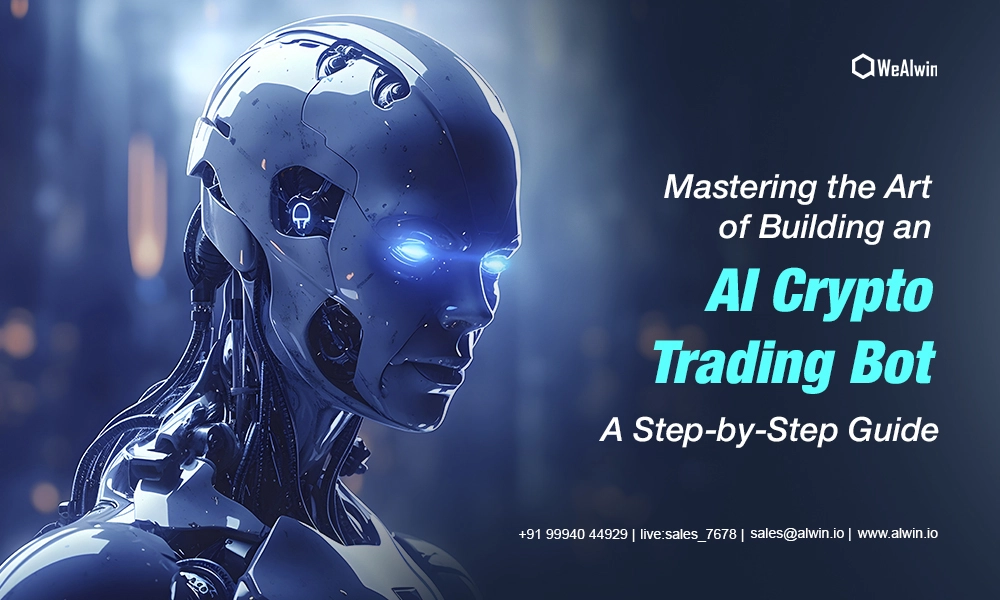The world of cryptocurrency trading has witnessed a significant rise in the adoption of artificial intelligence (AI) techniques. AI-powered crypto trading bots are revolutionizing the way trades are executed, enabling faster decision-making and more efficient trading strategies.
In this comprehensive guide, we will explore the key aspects of building an AI crypto trading bot from scratch, providing step-by-step instructions to help you navigate through the process seamlessly.
The Rise of AI in Cryptocurrency Trading
AI has become a game-changer in the realm of cryptocurrency trading, offering traders the ability to analyze massive volumes of data and make swift decisions based on advanced algorithms. As the complexity of the market continues to grow, AI brings unparalleled analytical capabilities and enables traders to automate their strategies, leading to improved efficiency and higher profitability.
Understanding the Power of Crypto Trading Bots
Crypto trading bots are simply software programs that execute trades automatically on the basis of predefined rules and algorithms. These bots leverage AI techniques to analyze market trends, identify trading opportunities, and execute trades without human intervention.
By eliminating emotional biases and enabling round-the-clock trading, crypto trading bots have the potential to optimize trading strategies and generate consistent profits.
Clarity on Terminology: AI vs. Machine Learning vs. Automation
Before diving into the world of AI-powered crypto trading bots, it's crucial to clarify some key terminology. While AI and machine learning (ML) are often used interchangeably, there is a subtle distinction.
AI refers to the broader concept of simulating intelligent behavior in machines, while ML focuses specifically on enabling machines to learn from data and improve their performance over time.
Automation, on the other hand, refers to the process of automating repetitive tasks or decision-making processes. In the context of crypto trading bots, AI and ML techniques are leveraged to automate trading strategies and decision-making processes, improving overall efficiency and profitability.
Setting the Foundation: Essential Knowledge for Building an AI Crypto Trading Bot
To build a successful AI crypto trading bot, it's crucial to have a solid foundation in cryptocurrency trading and understand the intricacies of the market.
Basics of Cryptocurrency Trading
Understanding Cryptocurrency Markets
Before delving into building a trading bot, it's crucial to understand the dynamics of cryptocurrency markets. Familiarize yourself with different types of cryptocurrencies, their underlying technology, and factors that influence their prices.
Key Terminologies and Concepts
Building a comprehensive trading bot requires a thorough understanding of key terminologies and concepts such as candlestick charts, order types (limit, market, stop-loss, etc.), leverage, and liquidity.
These concepts form the building blocks of trading strategies and help you make informed decisions.
Analyzing Crypto Market Data
Efficient analysis of crypto market data is critical for developing successful trading strategies. Acquaint yourself with various technical analysis indicators, such as moving averages, relative strength index (RSI), and Bollinger Bands, to gain insights into market trends and potential trading opportunities.
Introduction to AI in Crypto Trading
How AI Enhances Crypto Trading Performance
AI techniques, such as ML algorithms and neural networks, empower traders to analyze vast amounts of data and identify patterns that can yield profitable trading opportunities.
By leveraging AI, traders can enhance their trading performance through quicker decision-making, risk management, and improved prediction accuracy.
Types of AI Algorithms for Trading Bots
There are several types of AI algorithms that can be used in crypto trading bots, including statistical arbitrage, trend-following, mean reversion, and sentiment analysis. Each algorithm serves a specific purpose and can be combined to develop robust trading strategies.
Benefits and Limitations of AI in Crypto Trading
While AI offers immense potential in crypto trading, it's essential to be aware of its limitations. AI algorithms can be susceptible to overfitting, where the algorithms become too closely adapted to historical data and may not perform well in real-time.
Additionally, AI algorithms may not be immune to sudden market shifts and anomalies. It's crucial to continuously monitor and adapt AI models to changing market conditions.
Preparing Your Setup: Technical Requirements and Tools
To successfully build and deploy an AI crypto trading bot, you need to carefully consider the technical requirements and tools required for the task.
Selecting a Programming Language
Popular Languages for AI Crypto Trading Bots
Python, Java, and C++ are among the most popular programming languages used for building AI crypto trading bots. Python, with its extensive libraries such as Pandas, NumPy, and TensorFlow, offers a wide range of tools and frameworks that simplify the development process.
Evaluating their Pros and Cons
When selecting a programming language, consider factors such as ease of use, community support, libraries and tools available, and performance requirements. Python, for instance, has a large community and an extensive ecosystem of libraries tailored specifically for AI and data analysis, making it an ideal choice for many traders.
Choosing a Cryptocurrency Exchange
Criteria for Selecting an Exchange
Selecting a reliable cryptocurrency exchange is crucial for seamless trading. Consider factors such as security measures, liquidity, trading fees, available trading pairs, and regulatory compliance when choosing an exchange for your trading bot.
Recommended Exchanges for AI Crypto Trading Bots
Some popular exchanges that are commonly used by AI crypto trading bots include Binance, Coinbase Pro, Kraken, and Bitstamp.
These exchanges offer a wide range of cryptocurrencies, high liquidity, and robust APIs for seamless integration with trading bots.
Tips for Account Setup and Security
When setting up an account on a cryptocurrency exchange, ensure that you follow strict security protocols.
Enable two-factor authentication, use strong and unique passwords, and keep your API keys secure. Regularly review and update your security measures to protect your funds and trading bot.
Tip: Creating a separate trading account specifically for your bot can help you keep track of its performance and prevent any potential conflicts with your manual trades.
Working with Market Data and APIs
Accessing Real-Time Market Data
To build an effective trading bot, you need access to real-time market data. APIs provided by cryptocurrency exchanges offer a convenient way to retrieve market data, including price updates, trade history, and order book information.
Understanding Cryptocurrency APIs
Familiarize yourself with the API documentation of your chosen exchange to understand the available endpoints and the data they provide. Different exchanges may have varying API rate limits and data restrictions, so it's important to understand their usage policies.
Handling Data Storage and Retrieval
Efficient storage and retrieval of market data are crucial for developing robust trading strategies. Determine the most suitable method for storing and retrieving data, whether it's using a cloud-based database, a local database, or file-based storage.
Designing the Architecture: Frameworks and Strategies
In this section, we will discuss the key components to consider when designing the architecture of your AI crypto trading bot.
Building a Solid Trading Strategy
Identifying Trading Goals and Objectives
Clearly define your trading goals and objectives before developing your trading bot. Whether it's long-term portfolio growth, day trading, or generating consistent returns, having a clear vision will help you develop effective trading strategies.
Different Types of Trading Strategies
There are various types of trading strategies, including trend following, mean reversion, breakout, and scalping. Each strategy has its own unique approach to capitalizing on market opportunities. Choose a strategy that aligns with your trading goals and objectives.
Backtesting and Optimizing Strategies
Before deploying your trading bot, it's crucial to backtest and optimize your trading strategies using historical data. Backtesting allows you to evaluate the performance of your strategy under different market conditions and make the necessary adjustments to improve profitability.
Selecting an AI Framework
Popular AI Frameworks for Crypto Trading
There are several AI frameworks available that can be leveraged for building AI-powered crypto trading bots. TensorFlow, PyTorch, and scikit-learn are among the most popular frameworks used for developing ML models.
Evaluating Performance, Flexibility, and Support
When choosing an AI framework, consider factors such as performance, flexibility, ease of use, and community support. Evaluate the framework's ability to handle large datasets, its compatibility with your chosen programming language, and the availability of pre-trained models and tutorials.
Implementing Trading Indicators and Signals
Essential Indicators for AI Crypto Trading Bots
Technical indicators such as moving averages, RSI, MACD, and stochastic oscillators are commonly used in AI crypto trading bots to identify market trends and generate trading signals. Choose indicators that align with your trading strategy and goals.
Developing Custom Indicators
In addition to using pre-existing indicators, you may find it beneficial to develop custom indicators that offer unique insights into market dynamics. These custom indicators can be based on mathematical models, market sentiment analysis, or other proprietary algorithms.
Filtering and Validating Signals
To avoid false signals and reduce the risk of executing erroneous trades, it's crucial to implement robust signal filtering and validation mechanisms. Consider incorporating additional criteria, such as trade volume, trend consistency, and historical performance, to filter out unreliable signals.
Consult with our business experts to develop your AI Crypto Trading Bot! Chat with us on WhatsApp
Training the AI Bot: Data Gathering, Preprocessing, and Model Selection
Before your AI trading bot can make informed trading decisions, it needs to be trained on historical data and equipped with relevant features.
Collecting Historical Cryptocurrency Data
Data Sources and Considerations
To obtain historical cryptocurrency data, you can leverage various data providers, APIs, and cryptocurrency exchanges. It's essential to choose reliable and accurate data sources that offer a comprehensive historical dataset.
Methods for Data Cleaning and Preprocessing
Raw historical data often contains anomalies, missing values, and outliers, which can adversely affect the performance of your trading models. Implement effective data cleaning and preprocessing techniques, such as imputation, outlier detection, and normalization, to ensure the integrity and quality of your dataset.
Feature Engineering for AI Trading Models
Selecting Relevant Features
Feature engineering involves selecting and transforming relevant data attributes to create informative features that will drive the performance of your AI trading models. Consider incorporating features such as price volatility, trading volume, moving averages, and technical indicators to capture meaningful market patterns.
Applying Mathematical Transformations
In addition to selecting relevant features, applying mathematical transformations, such as logarithmic or exponential transformations, can enhance the predictive capabilities of your AI models and improve their performance.
Normalizing and Scaling Feature Data
Normalization and scaling of feature data are essential for ensuring that features with varying ranges and units are on a comparable scale. Techniques such as min-max scaling or standardization can be applied to normalize and scale feature data effectively.
Machine Learning Model Selection
Types of ML Models for Crypto Trading
Various ML models can be used to make predictions and trading decisions, including linear regression, support vector machines (SVM), random forests, and deep neural networks. Each model has its strengths and weaknesses, and the choice depends on factors such as the size of your dataset, complexity of the problem, and desired prediction accuracy.
Training and Testing Models
To evaluate the performance of your ML models, it's crucial to split your dataset into training and testing subsets. The training subset is used to train the model, while the testing subset allows you to assess the model's performance on unseen data. Techniques such as k-fold cross-validation can be employed to ensure robust evaluation.
Evaluating Performance Metrics
Performance metrics, such as accuracy, precision, recall, F1 score, and profit-loss ratio, help evaluate the effectiveness of ML models for crypto trading. Consider the unique characteristics of the cryptocurrency market when defining appropriate evaluation metrics for your trading bot.
Building and Deploying the AI Crypto Trading Bot
Now that you have gathered and preprocessed the data, selected the ML models, and designed your trading strategy, it's time to build and deploy your AI crypto trading bot.
Developing Trading Algorithms
Defining Trading Rules and Algorithms
Translate your trading strategy into algorithmic rules that your trading bot will follow. Define entry and exit conditions, risk management strategies, and position sizing rules to guide your bot's trading decisions.
Coding Algorithmic Trading Strategies
Translate your algorithmic rules into code using the programming language of your choice. Leverage the libraries and frameworks available in your selected programming language to implement your trading strategies effectively.
Handling Risk Management and Position Sizing
Implement robust risk management techniques, such as stop-loss orders, trailing stops, and limit orders, to manage potential losses and protect your trading capital. Define position sizing rules based on your risk appetite and portfolio diversification goals.
Integrating AI Models into Trading Bot
Incorporating ML Models into Trading Logic
Integrate your trained ML models with your trading logic to enable your trading bot to make data-driven decisions. Retrieve real-time market data and feed it into your ML models to generate predictions and trading signals.
Designing a Decision-Making Engine
Develop a decision-making engine that processes the predictions and trading signals generated by your ML models. This engine should incorporate your predefined trading rules, risk management strategies, and position sizing rules to execute trades.
Implementing Real-Time Prediction and Trading Execution
Ensure that your trading bot continuously retrieves and updates market data in real-time to generate up-to-date predictions and execute trades promptly. Implement mechanisms to handle order placement, execution, and confirmation seamlessly with the cryptocurrency exchange's APIs.
Deploying the Bot on a Cloud Infrastructure
Selecting a Cloud Provider
To ensure scalability, reliability, and accessibility, consider deploying your trading bot on a cloud infrastructure.
Choosing a reputable cloud provider, such as Amazon Web Services (AWS), Google Cloud Platform (GCP), or Microsoft Azure, offers a robust and scalable environment for running your trading bot.
Setting Up and Managing the Cloud Environment
Configure your cloud environment to include the necessary resources, such as virtual machines, storage, and networking, to support the deployment of your trading bot.
Utilize containerization technologies, such as Docker, to ensure portability and ease of deployment.
Ensuring Scalability, Reliability, and Security
Design your cloud infrastructure in a scalable and fault-tolerant manner to handle increased trading volumes and ensure uninterrupted operation.
Implement security measures, such as secure authentication protocols, network firewalls, and encryption, to protect your bot, trading data, and API keys.
Monitoring and Evaluating Trading Performance
Monitoring and evaluating the performance of your AI crypto trading bot is crucial for ensuring its effectiveness and success in the dynamic cryptocurrency market.
In this section, we will explore key aspects of tracking real-time trading performance and fine-tuning your trading strategy to maximize profitability.
Tracking Real-Time Trading Performance
Monitoring Metrics and Key Performance Indicators
Monitoring metrics and key performance indicators (KPIs) is essential to gain insights into the performance of your AI crypto trading bot. Key metrics to monitor include:
Return on Investment (ROI): Calculating the profitability of your trading activities.
Sharpe Ratio: Assessing the risk-adjusted returns of your bot.
Win Rate: Measuring the percentage of profitable trades.
Maximum Drawdown: Identifying the largest decline from a peak to a trough in your trading account.
Average Trade Duration: Analyzing the average time it takes for a trade to reach its conclusion.
By regularly tracking these metrics, you can evaluate the effectiveness of your trading bot and make necessary adjustments to improve performance.
Analyzing Trading Results and Performance Visualization
Analyzing trading results and visualizing performance is crucial for gaining a comprehensive understanding of your AI crypto trading bot's performance. Utilize data visualization techniques such as charts and graphs to visualize:
- Profit and loss over time.
- Trade execution frequency.
- Distribution of trades across different cryptocurrencies.
These visualizations can help identify patterns, trends, and potential areas of improvement in your bot's trading strategy.
Fine-Tuning the Trading Strategy
Optimizing Parameters and Hyperparameters
Fine-tuning the parameters and hyperparameters of your AI crypto trading bot is crucial for optimizing its performance. Parameters refer to inputs that directly affect trading decisions, such as stop-loss thresholds or position sizing.
Hyperparameters, on the other hand, influence the behavior and performance of the trading strategy, such as the learning rate or the number of neural network layers.
Optimization techniques like grid search or genetic algorithms can be employed to find the best combination of parameters and hyperparameters that maximize profitability.
Regularly analyze the impact of different parameter values on your trading results to continuously enhance your bot's performance.
Addressing Overfitting and Underfitting
Overfitting and underfitting are common challenges faced in developing AI crypto trading bots. Overfitting occurs when the bot performs well on historical data but fails to generalize to new market conditions.
Underfitting, on the other hand, happens when the bot fails to capture important patterns in market data.
To address overfitting, use techniques such as cross-validation or regularization methods to validate your bot's performance on unseen data.
To overcome underfitting, consider increasing the complexity of your bot's model or refining its feature selection process. Continuously monitoring and adjusting your bot's performance to strike a balance between overfitting and underfitting is essential for sustained profitability.
Adapting to Changing Market Conditions
The cryptocurrency market is known for its volatility and constantly changing dynamics. A successful AI crypto trading bot needs to adapt to these changing market conditions to capitalize on profitable opportunities and mitigate risks.
Regularly analyze and assess market trends, news, and events that may impact the cryptocurrency market.
By monitoring and incorporating such information into your trading strategy, you can ensure that your bot remains adaptable and responsive to fluctuations in market conditions.
Legal and Ethical Considerations in AI Crypto Trading
While building and deploying an AI crypto trading bot can offer significant advantages, it is crucial to navigate the legal and ethical landscape associated with cryptocurrency trading. Let's explore important considerations in this realm.
Compliance with Regulations
Understanding Legal Requirements
Before engaging in AI crypto trading, it is essential to thoroughly understand and comply with the legal requirements governing cryptocurrency trading in your jurisdiction. This includes being aware of regulations related to securities, anti-money laundering, and know-your-customer (KYC) policies.
Consult legal professionals or regulatory authorities to ensure your bot's operations align with the applicable laws and regulations.
Identifying Risks and Compliance Challenges
Identifying and managing potential risks and compliance challenges is vital for maintaining the legitimacy and sustainability of your AI crypto trading activities. Some common risks and compliance challenges include:
Market manipulation: Avoid engaging in activities that may manipulate prices or artificially influence trading volumes.
Data privacy: Safeguard user data and ensure compliance with relevant data protection laws
Cybersecurity: Implement robust security measures to protect your bot and trading account from cyber threats.
Financial regulations: Comply with requirements related to taxation, reporting, and auditing.
By proactively addressing these risks and compliance challenges, you can build trust with regulators and stakeholders while protecting yourself and your investors.
Ethical Implications and Responsible Trading
Transparency and Accountability
Ethical considerations should underpin the operation of your AI crypto trading bot. Transparency and accountability are paramount to ensuring fair and responsible trading practices.
Maintain transparency by disclosing the use of AI algorithms in your trading strategy and providing clear information about the risks associated with cryptocurrency trading.
Furthermore, implement mechanisms to hold yourself accountable for the actions of your bot. Regularly review and audit your bot's decisions to ensure they align with ethical trading practices and promote market integrity.
Ensuring Fairness and Avoiding Manipulation
Fairness and avoiding market manipulation are essential principles for responsible AI crypto trading. Avoid engaging in practices that may distort market conditions or exploit information asymmetry.
Implement robust risk management procedures to prevent conflicts of interest and ensure fair execution of trades. Adhere to industry best practices and ethical standards, working towards creating a transparent and trustworthy environment within the cryptocurrency market.
Conclusion
Building a successful crypto trading bot requires expertise and diligent management. As a leading crypto trading bot development company, we can help you unlock the power of automation while navigating the volatility of the crypto market.
Our comprehensive crypto trading bot development services include thorough research, careful bot design, and ongoing performance monitoring. We'll work closely with you to refine your bot's algorithms, adapt to market changes, and ensure your trades are guided by both AI insights and human judgment.
Ready to let your crypto trading bot become your financial compass?
Contact our team today to get started.



